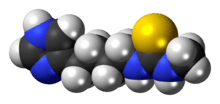Burimamide
 | |
 | |
| Names | |
|---|---|
| IUPAC name
1-[4-(1H-imidazol-5-yl)butyl]-3-methylthiourea | |
| Identifiers | |
| 34970-69-9 | |
| 3D model (Jmol) | Interactive image |
| ChEMBL | ChEMBL12160 |
| ChemSpider | 2297780 |
| KEGG | C07448 |
| PubChem | 3032915 |
| UNII | TN5A4OD2TV |
| |
| |
| Properties | |
| C9H16N4S | |
| Molar mass | 212.32 g/mol |
| Except where otherwise noted, data are given for materials in their standard state (at 25 °C [77 °F], 100 kPa). | |
| | |
| Infobox references | |
Burimamide is an antagonist at the H2 and H3 histamine receptors. It is largely inactive as an H2 antagonist at physiological pH,[1] but its H3 affinity is 100x higher. It is a thiourea derivative.
Burimamide was first developed by scientists at Smith, Kline & French (SK&F; now GlaxoSmithKline) in their intent to develop a histamine antagonist for the treatment of peptic ulcers.[2] The discovery of burimamide ultimately led to the development of cimetidine (Tagamet).[2]
See also
References
- ↑ Clayden, Jonathan; Greeves, Nick; Warren, Stuart; Wothers, Peter (2001). Organic Chemistry (1st ed.). Oxford University Press. p. 205. ISBN 978-0-19-850346-0.
- 1 2 "Tagamet®: Discovery of Histamine H2-receptor Antagonists". National Historic Chemical Landmarks. American Chemical Society. Retrieved June 25, 2012.
This article is issued from Wikipedia - version of the 1/7/2016. The text is available under the Creative Commons Attribution/Share Alike but additional terms may apply for the media files.